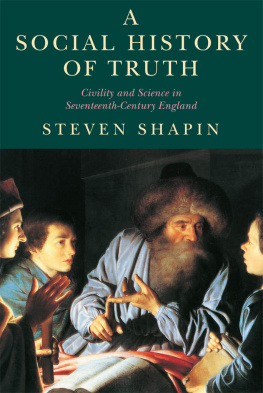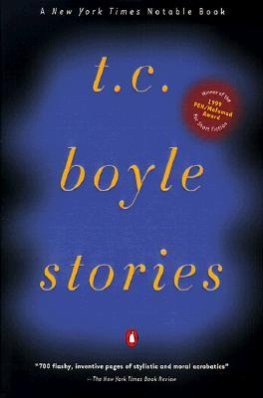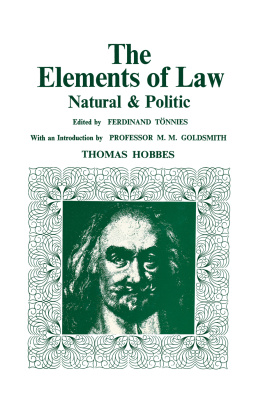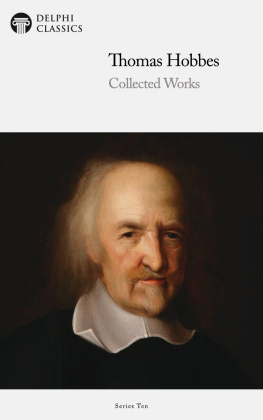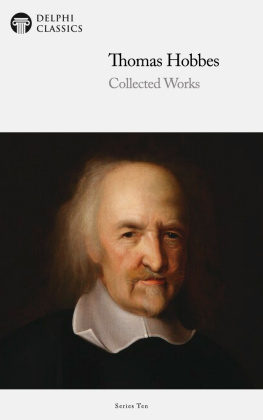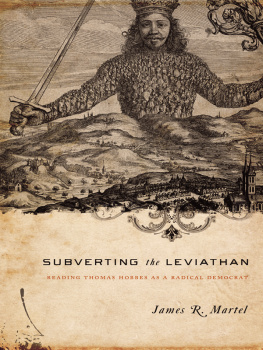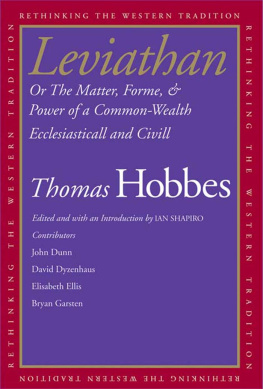LEVIATHAN AND THE AIR-PUMP

STEVEN SHAPIN & SIMON SCHAFFER
LEVIATHAN AND THE AIR-PUMP
HOBBES, BOYLE, AND THE EXPERIMENTAL LIFE
WITH A NEW INTRODUCTION BY THE AUTHORS

Copyright 1985 by Princeton University Press
Introduction to the 2011 edition copyright 2011
by Princeton University Press
Published by Princeton University Press,
41 William Street, Princeton, New Jersey 08540
In the United Kingdom: Princeton University Press,
6 Oxford Street, Woodstock, Oxfordshire OX20 1TW
press.princeton.edu
Cover illustration: A pneumatical engine and its parts, from Boyles
Spring and Weight of the Air, published in 1661
(engraving) (b/w photo) by English School (17th century).
Private Collection/The Bridgeman Art Library.
All Rights Reserved
First printing, 1985
First paperback printing, with corrections, 1989
Paperback reissue, with a new introduction, 2011
Library of Congress Control Number: 2011926951
ISBN: 978-0-691-15020-8
British Library Cataloging-in-Publication Data is available
This book has been composed in Linotron Baskerville
Printed on acid-free paper.
Printed in the United States of America
1 3 5 7 9 10 8 6 4 2
For our Parents
Every afternoon Father Nicanor would sit by the chestnut tree preaching in Latin, but Jos Arcadio Buenda insisted on rejecting rhetorical tricks and the transmutation of chocolate, and he demanded the daguerreotype of God as the only proof. Father Nicanor then brought him medals and pictures and even a reproduction of the Veronica, but Jos Arcadio Buenda rejected them as artistic objects without any scientific basis. He was so stubborn that Father Nicanor gave up his attempts at evangelization and continued visiting him out of humanitarian feelings. But then it was Jos Arcadio Buenda who took the lead and tried to break down the priests faith with rationalist tricks. On a certain occasion when Father Nicanor brought a checker set to the chestnut tree and invited him to a game, Jos Arcadio Buenda would not accept, because according to him he could never understand the sense of a contest in which the two adversaries have agreed upon the rules.
GABRIEL GARCA MARQUEZ, One Hundred Years of Solitude
What a blessing to mankind, in himself and in his writings, was the ingenious, humble, and pious Mr. Boyle; what a common pest to society was the fallacious, proud, and impious Hobbes! Accordingly we find the former bad adieu to this world with the utmost serenity, honour, and hope; while the other went out of it in the dark, with an odium on his name, as well as with terrible apprehensions of an unknown future.
W. DODD, The Beauties of History; or, Pictures of
Virtue and Vice Drawn from Examples of Men,
Eminent for Their Virtues or Infamous for
Their Vices (1796)
CONTENTS
I
Understanding Experiment
II
Seeing and Believing: The Experimental Production of
Pneumatic Facts
III
Seeing Double: Hobbess Politics of Plenism before 1660
IV
The Trouble with Experiment: Hobbes versus Boyle
V
Boyles Adversaries: Experiment Defended
VI
Replication and Its Troubles: Air-Pumps in the 1660s
VII
Natural Philosophy and the Restoration: Interests in Dispute
VIII
The Polity of Science: Conclusions
ILLUSTRATIONS
INTRODUCTION TO THE 2011 EDITION
Up for Air:
Leviathan and the Air-Pump
a Generation On
When Princeton University Press asked us whether we were interested in participating in a new edition of Leviathan and the Air-Pump: Hobbes, Boyle, and the Experimental Life, first published in 1985, we were pleased to have an opportunity to reflect on the circumstances of the books original composition and some aspects of its early reception. In addition to this substantial new introduction, a decision was made to omit the translation of Thomas Hobbess Dialogus physicus; otherwise, the text is unchanged.

There are two technologies especially relevant to this new edition of Leviathan and the Air-Pump. The first one is obvious: the air-pump. Its physical operation and its role in making seventeenth-century scientific knowledge were this books stated subjects. It has been said that what distinguished this way of telling a historical story about science is that its real hero was not a person but an instrument. The second technology is not so obvious, nor was it obvious to the authors when they wrote the book over a quarter century ago. Just as the air-pump was a device for making scientific knowledge of a certain kind, so this technology was a device for making historical knowledge of a certain kind. That technology was a typewriter.
Its useful to bear this second knowledge-making technology in mind since its workings were transparent to the authors in the mid-1980s when it served their knowledge-making purposes. But it was just about the last piece of work either of them produced using that technology. Within a year or so, like practically every other academic, they entered the digital age. They did not reflect on the relationship between the typewriters capabilities and limits, on the one hand, and the forms of intellectual and social order it produced, on the other. But they could have done so: the typewriter, the pristine sheet of bond paper, the little jars of Tipp-Ex or Wite-Out (if you came into the world of writing after the late 1980s, youll want to look up what those things were), the reflective pause before striking a key and confronting the relative permanence of ink newly deposited on cellulose, and the modes of interaction framed by the limits of the telephone and the postal systemits units then not known as snail mailfor conveying the physical forms of knowledgethen not known as hard copyfrom one person to a distant other. Who is to say that the limits, opportunities, and emotional texture of typewriter-based knowledge making are not significantly different from those based on the personal computer and the Internet?
That subject deserves another book, perhaps a book sharing some of the same sensibilities as those in Leviathan and the Air-Pump. There are aspects of the books current celebrity/notoriety that we find at least as worthy of curiosity and of interpretation as its initially bland reception, and we will later suggest some possible explanations.
It is a moment in changing scholarly traditions, changing cultural and institutional settings, changing conventions, problems, and purposes.
HISTORIOGRAPHIC TRADITION
There is a passage towards the end of the book thatperhaps more than any otherstands witness to the cultural setting out of which it came and that, at the same time, shows how the authors tried to effect change in that setting:
The language that transports politics outside of science is precisely what we need to understand and explain. We find ourselves standing against much current sentiment in the history of science that holds that we should have less talk of the insides and outsides of science, that we have transcended such out-moded
Historians and sociologists of science coming into the profession from, say, the early 1990s may not find it easy to understand what this was all about, and, if so, thats because certain of the categories addressed in that passage now scarcely exist in mainstream academic studies of science and historical change. Few respectable historians or sociologists of science now assess the relationship between what were once routinely referred to as internal and external factors; fewer still say that what they are trying to do is to assess the relative significance of these factors in scientific change; and hardly any say that a proper story about the factors is vital to defending the institution of modern science from political interference and scientific knowledge from distortion. This contest between the factors, and the notion that historians were supposed to adjudicate their relative importance, now seem locally antique. Advanced thinkers are now even uneasy with the very idea that one can reliably parse cultural and social fields into factors at all, treating the locutions, instead, as the conventions of different modes of academic inquiry. There are indeed some academic historians who still talk unself-consciously about internal and external factors, assessing their significance in scientific change, but the gesture is sometimes thought to mark them out as not-among-the-knowing, nave, amateur, disconnected from what counts as mainstream history of science. The disciplines
Next page

